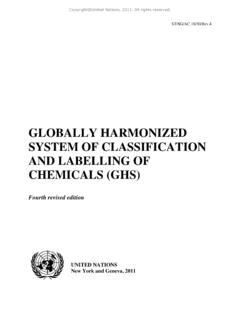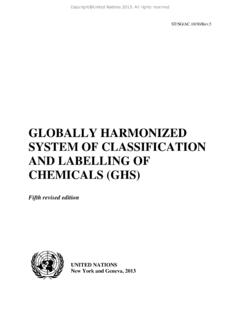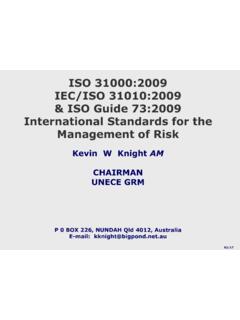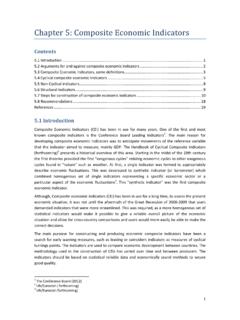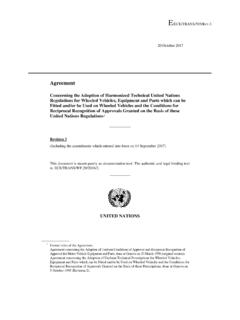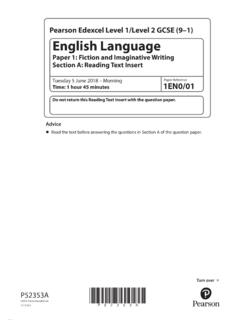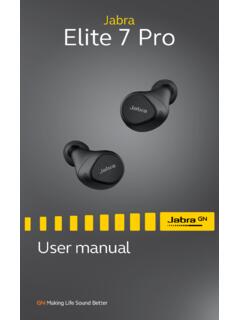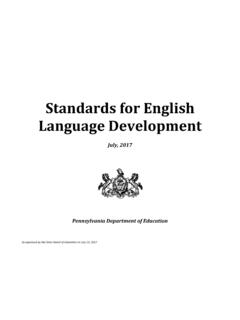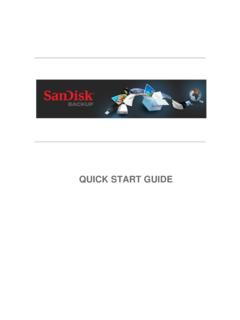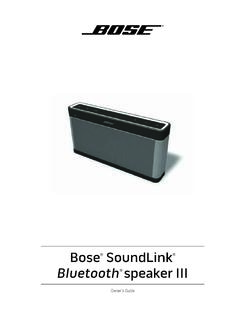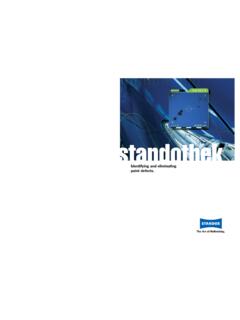Transcription of PART III - UNECE
1 - 319 - PART III CLASSIFICATION PROCEDURES, TEST METHODS AND CRITERIA RELATING TO CLASS 2, CLASS 3, CLASS 4, DIVISION , CLASS 8 AND CLASS 9 Copyright United Nations, 2009. All rights reservedCopyright United Nations, 2009. All rights reserved- 321 - CONTENTS OF PART III NOTE 1: The country or organisation of origin of each test method is indicated in brackets after each test name. NOTE 2: All test methods given in Part III of the Manual are recommended tests as only one test is given for each property. Section Page 30. INTRODUCTION TO PART 325 PURPOSE .. 325 SCOPE .. 325 31. CLASSIFICATION PROCEDURES, TEST METHODS AND CRITERIA RELATING TO FLAMMABLE AEROSOLS OF CLASS 2 .. 327 PURPOSE .. 327 SCOPE .. 327 CLASSIFICATION PROCEDURES FOR FLAMMABLE AEROSOLS .. 327 IGNITION DISTANCE TEST FOR SPRAY AEROSOLS.
2 332 ENCLOSED SPACE IGNITION TEST .. 336 AEROSOL FOAM FLAMMABILITY 341 32. CLASSIFICATION PROCEDURES, TEST METHODS AND CRITERIA RELATING TO LIQUID DESENSITIZED EXPLOSIVES AND FLAMMABLE LIQUIDS OF CLASS 343 PURPOSE .. 343 SCOPE .. 343 CLASSIFICATION PROCEDURES .. 343 TEST METHODS FOR DETERMINING flash POINT AND 346 TEST METHODS FOR DETERMINING SOLVENT SEPARATION AND SUSTAINED 347 Test Solvent separation test (UN) .. 347 Test Sustained combustion test (UN) .. 348 TEST METHODS USED FOR DETERMINING INITIAL BOILING POINT .. 352 33. CLASSIFICATION PROCEDURES, TEST METHODS AND CRITERIA RELATING TO CLASS 353 353 DIVISION 353 FLAMMABLE 353 Purpose .. 353 Scope .. 353 Classification procedure for readily combustible solids.
3 353 Test Test method for readily combustible solids (UN) .. 355 (Reserved) .. 358 SOLID DESENSITIZED EXPLOSIVES OF DIVISION .. 358 Copyright United Nations, 2009. All rights reserved- 322 - CONTENTS OF PART III (continued) Section Page DIVISION 359 SUBSTANCES LIABLE TO SPONTANEOUS 359 Purpose .. 359 Scope .. 359 Classification procedure for substances liable to spontaneous combustion .. 359 Test Test method for pyrophoric solids (UN) .. 362 Test Test method for pyrophoric liquids (UN) .. 363 Test Test method for self-heating substances (UN) .. 364 DIVISION 366 SUBSTANCES WHICH IN CONTACT WITH WATER EMIT FLAMMABLE GASES .. 366 Purpose .. 366 Scope .. 366 Classification procedure for substances which in contact with water emit flammable gases .. 366 Test Test method for substances which in contact with water emit flammable gases (UN).
4 367 34. CLASSIFICATION PROCEDURES, TEST METHODS AND CRITERIA RELATING TO OXIDIZING SUBSTANCES OF DIVISION 369 PURPOSE .. 369 SCOPE .. 369 CLASSIFICATION 369 TEST METHODS FOR OXIDIZING SUBSTANCES .. 370 Test Test for oxidizing solids (UN) .. 370 Test Test for oxidizing liquids (UN) .. 374 35. Reserved for classification procedures, test methods and criteria relating to Class 381 36. Reserved for classification procedures, test methods and criteria relating to Class 383 37. CLASSIFICATION PROCEDURES, TEST METHODS AND CRITERIA RELATING TO SUBSTANCES OF CLASS 385 PURPOSE .. 385 SCOPE .. 385 CLASSIFICATION 385 TEST METHODS FOR CORROSION TO METALS .. 385 Introduction.
5 385 Test Test for determining the corrosive properties of liquids and solids that may become liquid during transport as dangerous goods of Class 8, packing group III.. 385 Copyright United Nations, 2009. All rights reserved- 323 - CONTENTS OF PART III (continued) Section Page 38. CLASSIFICATION PROCEDURES, TEST METHODS AND CRITERIA RELATING TO CLASS 389 389 AMMONIUM NITRATE FERTILIZERS CAPABLE OF SELF-SUSTAINING 389 Purpose .. 389 Scope .. 389 Classification 389 Test "Trough" test for determination of the self-sustaining exothermic decomposition of fertilizers containing nitrates .. 390 LITHIUM METAL AND LITHIUM ION 394 Purpose.
6 394 Scope .. 394 Procedure .. 398 Test Altitude simulation .. 398 Test Thermal test .. 398 Test Vibration .. 399 Test Shock .. 399 Test External short circuit .. 400 Test Impact .. 400 Test 401 Test Forced 401 Copyright United Nations, 2009. All rights reservedCopyright United Nations, 2009. All rights reserved- 325 - SECTION 30 INTRODUCTION TO PART III Purpose Part III of the Manual presents the United Nations schemes for the classification of: (a) Flammable aerosols (see section 31 of this Manual and special provision 63 of Chapter of the Model Regulations); (b) Flammable liquids and liquid desensitized explosives of Class 3 (see section 32 of this Manual and Chapter of the Model Regulations); (c) Readily combustible solids and solid desensitized explosives of Division (see sub-section of this Manual and Chapter of the Model Regulations); (d) Pyrophoric and self-heating substances of Division (see sub-section of this Manual and Chapter of the Model Regulations).
7 (e) Substances which in contact with water emit flammable gases of Division (see sub-section of this Manual and Chapter of the Model Regulations); (f) Oxidizing substances of Division (see section 34 of this Manual and Chapter of the Model Regulations); (g) Corrosive properties of substances of class 8 (see section 37 of this Manual and Chapter of the Model Regulations); (h) Ammonium nitrate fertilizers capable of self-sustaining decomposition of Class 9 (see sub-section of this Manual); and (i) Lithium cells and batteries of Class 9 (see sub-section of this Manual). Part III contains some classification procedures, test methods and criteria which are also given in the Model Regulations. Sections 35 and 36 are reserved, to allow for possible future developments, for Classes 6 and 7 respectively. Scope The appropriate classification procedure should be undertaken before a new product is offered for transport.
8 The producer or other applicant for classification of a new product should provide: (a) Adequate information concerning the names and characteristics of the substance or article; (b) The results of all relevant tests which have been done; and (c) The proposed classification with any subsidiary risk requirements. Copyright United Nations, 2009. All rights reservedCopyright United Nations, 2009. All rights reserved- 327 - SECTION 31 CLASSIFICATION PROCEDURES, TEST METHODS AND CRITERIA RELATING TO FLAMMABLE AEROSOLS OF CLASS 2 Purpose This section presents the United Nations scheme for the classification of flammable aerosols. The text should be used in conjunction with the classification principles given in Chapters and (special provision 63) of the Model Regulations, the flow charts given here in figures , and and the tests prescriptions given in sub-sections , and of this Manual.
9 The test procedures outlined here adequately assess the relative hazard of flammable aerosols so that an appropriate classification can be made. For the purposes of this section the following definitions apply: Aerosols or aerosol dispensers are non-refillable receptacles meeting the requirements of section of the Model Regulations, made of metal glass or plastics and containing a gas, compressed, liquefied or dissolved under pressure, with or without a liquid, paste or powder, and fitted with a release device allowing the contents to be ejected as solid or liquid particles in suspension in a gas, as a foam, paste or powder or in a liquid state or in a gaseous state; Flammable components are flammable liquids, flammable solids or flammable gases and gas mixtures. This designation does not cover pyrophoric, self-heating or water-reactive substances. NOTE 1: A flammable liquid means a liquid having a flash point of not more than 93 C.
10 Test methods for determining the flash point are given in sub-section of this Manual; NOTE 2: For the definition of flammable solids, see paragraph of the Model Regulations. Classification procedures, test methods and criteria relating to flammable solids of Division are given in sub-section of this Manual; NOTE 3: A flammable gas is a gas having a flammable range with air at 20 C and a standard pressure of kPa. Scope Aerosols offered for transport shall be subjected to the classification procedures as set out in special provision 63 of Chapter of the Model Regulations and, for flammability, shall be subjected to the classification procedures as set out in this section. The classification procedure shall be undertaken before a new product is offered for transport. NOTE: Aerosol dispensers not submitted to flammability classification procedures in this sub-section shall be classified as extremely flammable.


